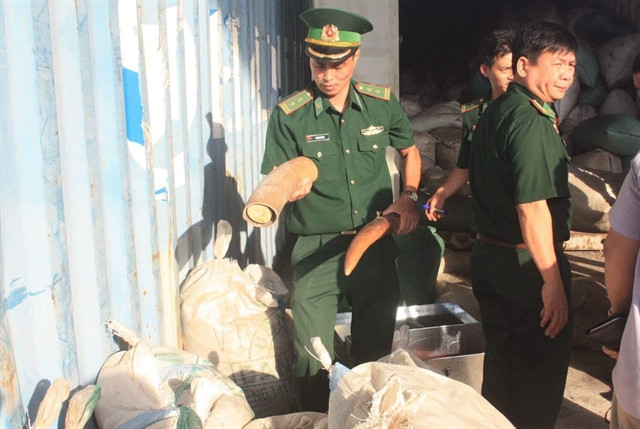 |
| Border guard and customs forces check a container of illegal ivory cargo disguised as fine art at Đà Nẵng's Tiên Sa Port. — VNS Photo Công Thành |
Ninety per cent of the world trade is seaborne and an estimated 72-90 per cent of illicit wildlife volumes are trafficked through maritime transport, meaning detecting and intercepting wildlife shipments at maritime ports is critical.
The figures were revealed on February 14 at a workshop on ‘Strengthening inspection, detection, investigation and handling illegal wildlife trade through seaports', co-hosted by the Management Board for Forestry Projects under the Ministry of Agriculture and Rural Development (MARD); the General Department of Việt Nam Customs, United Nations Office on Drugs and Crime (UNODC), US Department of State, USAID. The conference draw the participation of customs representatives from major seaport authorities in HCM City, Hải Phòng, Đà Nẵng, Quy Nhơn and TRAFFIC.
The workshop provided participants with information on the maritime cargo inspection and screening procedures to control and detect wildlife trafficking, including the Customs Container Control Programme, technology interventions to improve detection rates, including new x-ray innovations supported by USAID and the US Department of State, and new guidelines on wildlife trafficking adopted by the International Maritime Organisation.
Examples of interdepartmental, international, and cross-sector coordination and cooperation in countering wildlife trafficking, opportunities and the latest trends of this transnational crime were also highlighted.
“Wildlife trafficking is a cross-border, transnational crime. We focus on capacity building and supporting stakeholders of Việt Nam, including customs and port authorities, to effectively and responsibly enforce international treaties,” said director of the Management Board for Forestry Projects (MBFP), Đỗ Quang Tùng.
Thought to be the world’s largest known ivory seizure, in March 2019 Việt Nam Customs seized over nine tonnes of ivory at Đà Nẵng port. The seizure represents over 1,000 elephants and brought the amount of ivory seized in Việt Nam since 2004 to over 70 tonnes.
“Countering wildlife trafficking is a global priority for the US Government. USAID supports interagency collaboration, transboundary cooperation, and reforms to policies and practices to ensure transnational wildlife crime is prevented,” said Annie Wallace, director of Office of Climate Change, Energy and Environment, USAID Việt Nam.
Participants highlighted opportunities to strengthen the detection and interception of wildlife trafficking cases after a tour at Đà Nẵng port.
 |
| Participants join the workshop on ‘Strengthening inspection, detection, investigation and handling illegal wildlife trade through seaports' in Đà Nẵng. — Photo courtesy WWF |
"Wildlife trafficking is a growing concern globally, threatening not only biodiversity but also ecosystems vital for climate change mitigation, domestic and international economies. Investigating and intercepting the perpetrators of this illegal trade is a challenge, requiring coordination and collaboration between enforcement agencies and the maritime shipping industry. Through USAID’s Saving Threatened Wildlife project, we aim to change the perception that trafficking wildlife to Việt Nam is a low risk, high reward activity," said Michelle Owen, Chief of Party - Saving Threatened Wildlife, WWF.
Supported by USAID and implemented under the Ministry of Agriculture of Rural Development (MARD) by WWF, TRAFFIC and ENV, the Saving Threatened Wildlife project supports efforts to counter wildlife trafficking.
USAID partners with MARD to assist Việt Nam’s customs and seaport authorities to use technology to counter wildlife trafficking.
USAID’s Saving Threatened Wildlife project, implemented by WWF, convened agencies to discuss tools and technology that combat wildlife trafficking through improved detection and interception at maritime ports. — VNS